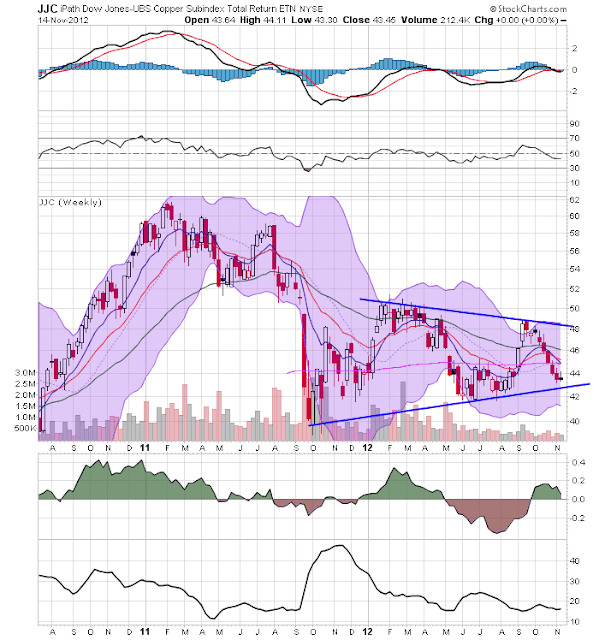- by New Deal democrat
One picture tells you all you really need to know about both the monthly and weekly data released in the past week. Below is a screen capture of a weather radar at about 10 p.m. on October 30, showing the eye of Hurricane Sandy passing directly over the city of Philadelphia:

Because the storm approached from the southeast, the "right" side of the storm, which is the strongest, was actually northeast of the eye as it crossed New Jersey. In other words, the southern half of the NYC metro area along with most of the Jersey Shore took a direct hit. Between the NYC and Philly metro areas, about 30 million people, or 10% of the entire US population, had More Important Things To Do in the last few days of October and the first part of November than produce and consume goods and services. Almost all of the data reflects that reality. Since the effects of Hurricane Sandy are overwhelming almost all the other signal in the economic data, it will be impossible for the next month or so for the actual underlying strength or weakness to show up in the monthly numbers. We'll begin to see what is really going on in the weekly numbers, but probably not until next week.
For the record, the monthly data released this past week was all negative. Retail sales were down, industrical production was down, capacity utilization was down, the Empire and Philly Fed Indexes showed contraction, and producer prices were down. Only consumer prices for October were up, +0.1%.
Almost all of the high frequency weekly indicators this past week were again affected by Hurricane Sandy, so they must be treated with lots of skepticism. The influence of the hurricane should wane beginning next week.
Same Store Sales and Gallup consumer spending varied from very weakly positive to substantially negative:
The ICSC reported that same store sales for the week ending October 26 rose +0,7%w/w and were up +1.8% YoY. Johnson Redbook reported a weak 1,6% YoY gain. Johnson Redbook has consistently been lower than the other series for consumer spending. The 14 day average of Gallup daily consumer spending as of November 8 was $65, compared with $71 last year for this period. This is the second week in a row of a very poor showing in a long time for Gallup. The effects of Sandy will still show up for about one more week.
Bond yields were mixed and credit spreads reamined close to their recent lows:
Weekly BAA commercial bond yields declined -0.03% this week to 4.46%. Yields on 10 year treasury bonds fell -0.06%to 1.68% The credit spread between the two increased by 0.01% to 2.78, just off its 15 month low. This remains an excellent trend, as it demonstrates a lack of fear of corporate default.
Housing reports were all quite positive, reflecting the continued rebound in this sector:
The Mortgage Bankers' Association reported that the seasonally adjusted Purchase Index rose 11% from the prior week, and is also up 22% YoY. These remain in the upper part of their 2+ year range. The Refinance Index also rose 13% for the week, moving back towards recent multi-year highs.
The Federal Reserve Bank's weekly H8 report of real estate loans this week rose by 34 w/w to 3563, the highest number in several years. The YoY comparison increased to +1.8%, and is 2.5% above its bottom.
YoY weekly median asking house prices from 54 metropolitan areas at Housing Tracker increased +1.5% from a year ago. YoY asking prices have been positive for over 11 months, although this is the weekest YoY comparison in many months.
Money supply remains generally positive:
M1 declined -0.9% for the week, but increased +1.6% month over month. Its YoY growth rate declined slightly to +13.4%. Real M1 also declined to +11.2% YoY. M2 was up +0.4% for the week, and was up 0.8% month over month. Its YoY growth rate increased slightly to 7.5%, so Real M2 remained steady at 5.3%. The growth rate for real money supply remains quite positive.
Employment related indicators were pretty awful:
The Department of Labor reported that Initial jobless claims rose from 355,000 last week to 438,000. The four week average rose by 13,250 to 383,250. New Jersey had been unable to report a week ago, and has indicated that initial claims there surged in the wake of Sandy.
The American Staffing Association Index was again level at 95, the same level at which has been for over 2 months. The sieways trend in this index is similar to last year.
The Daily Treasury Statement showed that for the first 10 days of November, $72.0 B was collected vs. $68.8 B a year ago, a $3.2 B increase. For the last 20 days ending on Thursday, $125.1.5 B was collected vs. $127.7 B for the comparable period in 2011, a decline of $2.6 B or -2.0%. This is the first time in many months that the 20 day YoY comparison was negative.
Rail traffic remained negative YoY, but still due to coal, while the diffusion index decreased considerably:
The American Association of Railroads reported that total rail traffic was down -11,600 carloads YoY, or -2.2%. This is actually an improvement over the last few weeks. Non-intermodal rail carloads were again off a large -5.4% YoY or -16,100, once again entirely due to coal hauling which was off -21,000. Excluding coal, carloads were up 4900. Negative comparisons declined to 8 types of carloads from 11. Intermodal traffic was up 4500 or +1.9% YoY.
Finally, the price of oil rose slightly again while gasoline fell, but gasoline usage was positive:
Gasoline prices fell another $.04 last week to $3.45. This is still higher than last year at this time. Oil prices per barrel increased from $86.07 to $87. Surpirsingly, Gasoline usage was actually UP for one week at 8908 M gallons vs. 8625 M a year ago, or +3.3%. The 4 week average at 8638 M vs. 8579 M one year ago, was again up, +0.7% YoY.
Turning now to the high frequency indicators for the global economy:
The TED spread advanced slightly higher off its 52 week low, up to 0.24. The one month LIBOR fell once again to yeat another new 52 week low of 0.2075. Both are well below their 2010 peaks.
The Baltic Dry Index rose from 940 to 1036, well above its recent 52 week low of 662. The longer term declining trend in shipping rates for the last 3 years remains. The Harpex Shipping Index remained at its 52 week low of 367.
Finally, the JoC ECRI industrial commodities index rose from 118.99 to 120.04. It was again slightly positive YoY.
Very little should be read into the data this week and for the past several weeks, as the change in most has been all about Hurricane Sandy. That being said, housing, money supply, bank overnight rates, and corporate yields and credit spreads all remained very positive. Gas prices are for now a positive, and usage has actually increased slightly. Other commodities are neutral. Rail ex-coal is also up.
Employment- and consumption-related data took big hits. Rail including coal remained down.
Jobless claims should continue to be swamped by the affects of Sandy again next week, but other high frequency indicators should return closer to normal. It will lead monthly data, as to which November's data, reported a month from now, will still be affected by the Hurricane. In the meantime, have a nice weekend.


















































